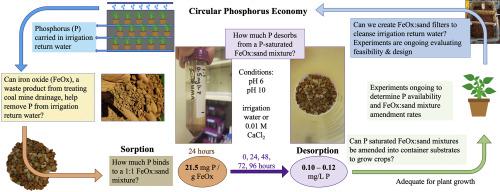Ecological Engineering ( IF 3.9 ) Pub Date : 2021-01-16 , DOI: 10.1016/j.ecoleng.2021.106153 Sarah A. White , William H.J. Strosnider , Megan E.M. Chase , Mark A. Schlautman

|
Development of low-cost strategies enabling phosphorus (P) use, recovery, and reuse across multiple economic sectors is needed to ensure its long-term availability for those industries that require P to enhance plant productivity. Irrigation return water from conventional agriculture and specialty crop production remains a source of excess P loading to aquatic ecosystems. Low-cost and technology treatment options are critical for the long-term economic and environmental sustainability of agricultural producers. To address P removal with a sustainable lens, we identified iron oxides (FeOx, a waste product from treating coal mine drainage) as a potential substrate for P sorption, and further evaluated the potential for reuse of P-saturated FeOx as a fertilizer source. The overall objectives of this study were to quantify P sorption, desorption, and plant availability of P adsorbed to FeOx. Batch sorption experiments were conducted to measure the effect of mixing FeOx with silica sand (1:1; FeOx:sand, by mass) on P sorption capacity. The sorption capacity of the FeOx:sand mixture was 21.5 mg P/g FeOx using deionized water. Less than 1% of initially adsorbed P desorbed over 96 h in treatments using irrigation reservoir water adjusted to either pH 6.0 or pH 10.0, demonstrating the stability of the sorption complexes against pH changes expected in irrigation return water systems. Plant available P, which we define as P that desorbed after contact with a CaCl2 solution, ranged from 0.10–0.12 mg/L P; this range is within nutrient recommendations for most plants. Phosphorus-saturated FeOx may be suitable as a fertilizer amendment, as well as a sustainable option for P removal from water. This research provides the foundation for a circular P economy, with viable P treatment and reuse paired with managing a waste product from another widespread industry.
中文翻译:

用再生的氧化铁去除植物苗圃灌溉回水中的磷并进行再利用
需要开发低成本策略以实现磷在多个经济领域的使用,回收和再利用,以确保其长期可用于那些需要磷以提高工厂生产率的行业。常规农业和特种作物生产的灌溉回水仍然是水生态系统中过量磷的来源。低成本和技术处理方案对于农业生产者的长期经济和环境可持续性至关重要。为了用可持续的透镜解决磷去除问题,我们确定了氧化铁(FeOx,一种处理煤矿排水的废物)作为潜在的P吸附基质,并进一步评估了将P饱和FeOx用作肥料来源的潜力。这项研究的总体目标是量化P的吸附,解吸,以及吸附到FeOx上的磷的工厂利用率。进行了分批吸附实验,以测量FeOx与硅砂(1:1; FeOx:砂,按质量计)混合对P吸附能力的影响。使用去离子水,FeOx:砂混合物的吸附容量为21.5 mg P / g FeOx。在使用调节至pH 6.0或pH 10.0的灌溉水库的处理过程中,经过96小时的解吸,最初吸附的P不到1%,证明了吸附复合物对灌溉回水系统中预期的pH变化的稳定性。植物有效磷,我们定义为与CaCl接触后解吸的P 使用去离子水,砂混合物为21.5 mg P / g FeOx。在使用调节至pH 6.0或pH 10.0的灌溉水库的处理过程中,经过96小时的解吸,最初吸附的P不到1%,证明了吸附复合物对灌溉回水系统中预期的pH变化的稳定性。植物有效磷,我们定义为与CaCl接触后解吸的P 使用去离子水,砂混合物为21.5 mg P / g FeOx。在使用调节至pH 6.0或pH 10.0的灌溉水库的处理过程中,经过96小时的解吸,最初吸附的P不到1%,证明了吸附复合物对灌溉回水系统中预期的pH变化的稳定性。植物有效磷,我们定义为与CaCl接触后解吸的P2种溶液,范围从0.10-0.12 mg / LP;该范围在大多数植物的营养建议范围内。磷饱和的FeOx可能适合作为肥料的改良剂,也是从水中去除磷的可持续选择。这项研究为循环磷经济提供了基础,可行的磷处理和再利用与管理另一个广泛行业的废品相结合。











































 京公网安备 11010802027423号
京公网安备 11010802027423号